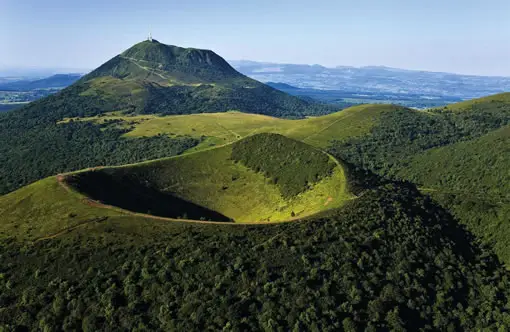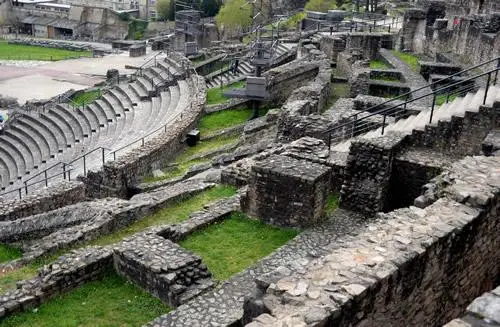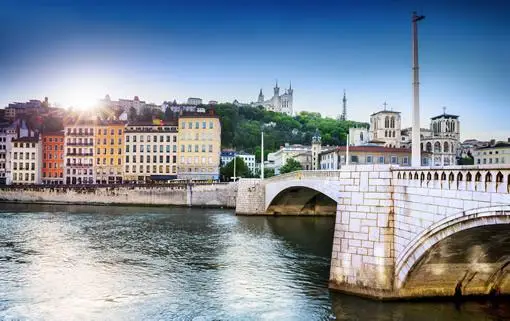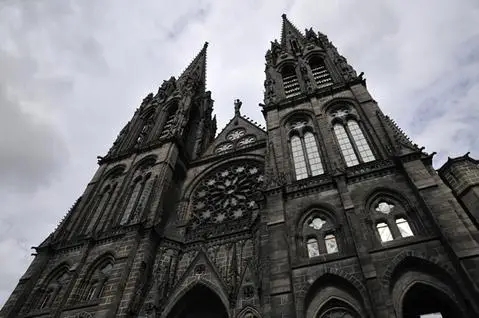Auvergne-Rhône-Alpes
Visit the rustic and quiet Auvergne-Rhône-Alpes region of France
Embark on a journey through Auvergne-Rhône-Alpes, a stunning region in southeastern France that captivates visitors with its diverse landscapes, rich history, and thriving culture. From majestic mountains and picturesque vineyards to vibrant cities and quaint villages, this region is a treasure trove of unforgettable experiences. Explore the beauty and allure of Auvergne-Rhône-Alpes as we guide you through its must-see destinations and attractions.
Auvergne
Anchoring the center of France is the Massif Central, a rugged plateau of ancient granite and hardened lava. The landscape is punctuated by volcanic peaks and deep river gorges. This is the land of the Auvergne, a region of natural beauty and dramatic landscapes, located midway between Paris and the Mediterranean sea.
The Auvergne is believed to have been inhabited since prehistoric times. In fact, regional artifacts suggest that the Celts lived here as early as 400 BC. Today, the Auvergne boasts some of France’s most beautiful Romanesque churches and Renaissance era palaces. The first cathedral built in the region was erected by Saint Namace in 450 AD in present day Clermont-Ferrand. The cathedral was rebuilt in the Gothic style beginning in the thirteenth century.

A major natural monument in the Auvergne is the Puy de Dome an extinct volcano which rises 1,465 meters (4,807 feet) above sea level. The peak provides breathtaking views of the Puy mountain chain and the green plains below. A winding road takes visitors to the peak, where remains of the Roman Temple of Mercury can still be seen. Blaise Pascal performed his famous experiment on the weight of air here in 1648.
The area is a paradise of outdoor activities, including skiing, rafting, biking, golfing, hiking, and hang-gliding. Lakes Guery, Aydat, Pavin, and Chambon provide excellent opportunities for water sports such as canoeing, fishing, swimming, and sailing.
The region is renowned for its cheeses. Widely-available selections include the blue cheeses Fourme d’Ambert and Bleu d’Auvergne, as well as Cantal, Salers, and St-Nectaire. Local dishes include pounti, a souffle-like creation composed of ham, eggs, vegetables, and cream.
The Charming Rhône-Alpes Region
The Rhône-Alpes region is located in the south eastern part of France. The region is just two hours from Paris via high speed TGV train.
The Rhône-Alpes is a diverse region with Europe’s highest peak (Mont Blanc), seemingly endless lavender fields, clear blue lakes, and historic vineyards.

The capital of the Rhône-Alpes region is the city of Lyon, which is France’s de facto technological and medical center. The region is home to 9 universities and 31 graduate business schools. Roman ruins can also be found throughout the city.
Great and inventive cooking is one of the Rhone Alpes most cherished traditions. Famous French chefs such as Bise, Blanc, Bocuse, Chapel, Chavent, Gagnaire, Orsi, Pic, Point, all call the Rhône-Alpes home.
Lyon – World Heritage City
A friend who went for a gap year in Lyon said he would never live anywhere else if he returned to France. This amazed me. Not Paris? Then other friends from Provence, who had always skirted Lyon via highway as they headed to relatives for the summer, wondered why anyone would even get off the highway to see it.
Now I really had to visit. All due respect to my Provence friends. You are wrong. What a lovely place Lyon is.
High speed rail from Paris brings you to the central station within 90 minutes. From there it’s easy enough to walk the city. If it’s really pouring, take a cab or Uber to the Old Town area. Or maybe to Presqu’ile, the
island between the Rhone and Saone rivers that make up the heart of Lyon.
Lyon does not have a Louvre or grand boulevards. What it does have is a silk museum, nod to the centuries of silk-making in the city, a thriving art scene, and, famously, a food scene.
What is Lyon famous for?
Native son Chef Paul Boucouse, who lived into his 90’s, reinvented French food with nouvelle cuisine, and the city has attracted up-and-coming chefs ever since. Lyon is perfectly scaled for walking. Once in the Old Town (narrowly saved from total demolition in the 60’s – it took a national campaign to thwart the mayor) and either take the funicular to the highest hill to see the old Roman Amphitheater (dating from 15 b.c.) and the 19th century Notre Dame Basilica, or get your steps in by taking the picturesque medieval steps all the way up. Personally, I took the funicular up and the steps down. I’m not crazy.
Wherever you walk you will glimpse one of the rivers. But what you must not do is miss walking
through one of the 40 or so traboules (passages) that lace through the city. Some date from the Romans, used by residents to get down to the river for water without too much fuss. Others were vastly improved during the Middle Ages, the better to dodge marauders. That applied to the Nazis in WWII as well. Lyon was the de facto capital of the French Resistance.
But back to food. You can’t say a city with a street named Rue du Bœuf is not food-obsessed. Between the Boucouse Institute, his training restaurants, his competitor’s restaurants, and the venerable bouchons, a day trip to Lyon just to eat is perfectly reasonable, leaving behind Paris for even better food. Yeah. Not kidding about that. On my hotel concierge’s recommendation, I went to the Old Town and had a prix fixe lunch on, yes, Rue du Bœuf. It was glorious, though forget about fussing about the wine.
It’s either house red or house white. With the Rhone nearby, it was not bad. I also wanted water and asked the waitress for “Un carafe d’eau.” She gestured to the table next to mine. We were to share. My fellow diner spoke English as it happened and indeed poured me a glass of water. Lyon is friendly like that.
Staying overnight is ideal but not necessary. Come to Lyon and eat, walk it off, snooze back to Paris on the train. Like I did. Well on one trip.
On another I needed to catch a connecting flight to Amsterdam and far too casually caught the train to the airport kind of late, barely making the flight because a turnstile jumper was ushered off the train when it stopped for a while as he was ejected. He was removed by an admirably confident small but might young French woman in heels and an official uniform, sporting an emphatic attitude. She was not letting it go. Seeing the big hulk skulk off the train was not quite worth missing a plane. But close.
Book a day trip to Lyon from Paris with us!
How do you pronounce Lyon in English?
Lyon is pronounced as LEE-on in English.
Lyon is a city of history. Over two thousand years of history have left their mark on the city’s landscape. From Roman ruins to the medieval old town to the fine arts museum, it isn’t a surprise the Lyon is listed as a World Heritage City by UNESCO.
We offer a day trip to Lyon from Paris and highly recommend a visit to France’s “second city”.

Situated in the heart of the Rhône-Alpes region, it is the third largest city in France with a population of about 500,000.
It is also world-renowned for its restaurants and art. With over 200 hotels, the city offers a wide range of accommodation options.
Lyon – Some Highlights
- Roman Theatres and then old town
- Boat trips along the Rhone river
- Silk workshops
- Fine arts Museum
- Downtown Market
More Resources…
- More photos available on our Link Paris Pinterest page.
- The official Lyon Tourist Office website.
Clermont-Ferrand – A city of history
The city of Clermont-Ferrand is located at the northern end of the mountainous Massif Central; it is the capital of the Auvergne region of France. The city’s history dates back to the Roman era and was also an important city in ancient Gaul.
You don’t usually think of volcanoes when you think of France, but indeed they ring the city of Clermont-Ferrand. As with much of this part of France, the city was under Roman rule for centuries. It was renamed Clermont in the 9th century. Christianity played a major role in the cities rise. In fact, the First Crusade was proclaimed and launched from Clermont.
So why the hyphen with Ferrand?

Local nobles, fed up with religious rule, started the neighboring town of Ferrand in 1551. Ferrand came under Royal protection in 1610. In 1731 Louis XIV joined then two cities of Clermont and Ferrand by royal edict.
To this day, there are two downtowns, each with an old town area near their respective basilicas. The city is the world headquarters of Michelin tires and the company was founded here. As for local culture, there is a world famous Short Film Festival held every February and a jazz festival each October.
Local specialty foods lean toward meat and potatoes; most notable is the Truffade, a large grated potato pancake stuffed with cheese.
Visit the Clermont Auvergne tourist office for more information about Auvergne.
Contact us to build the perfect France vacation.